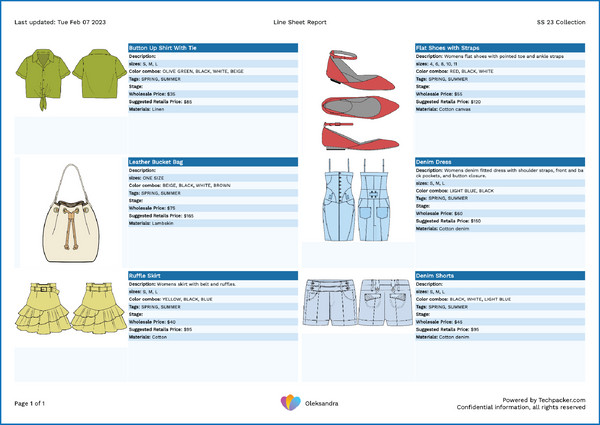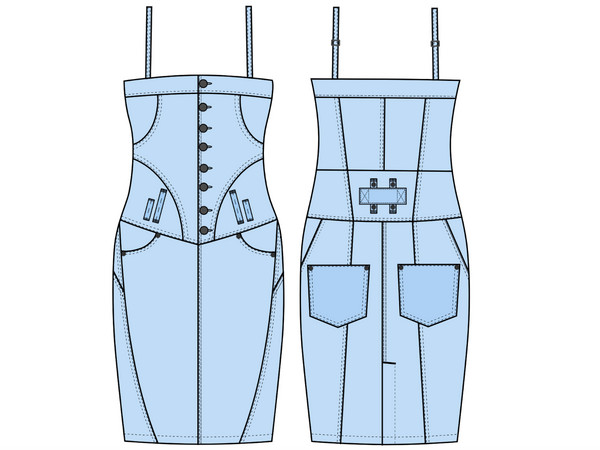Line Sheet Fashion is your ultimate sales tool, particularly in the dynamic world of menswear. Mens-fashion.net provides the expertise you need to create line sheets that not only impress but also convert potential buyers into loyal customers. By incorporating elements of a fashion catalog, price list, and order form, you present a comprehensive overview of your collection, ensuring a streamlined and efficient buying process for retailers. Ready to elevate your brand’s wholesale strategy? Let’s explore how a meticulously crafted line sheet can set you apart.
1. What Exactly Is a Fashion Line Sheet?
A fashion line sheet is a succinct overview of your clothing line, designed to provide potential buyers with essential product information for placing orders. It’s your brand’s calling card, a visual and informative document that showcases your designs, pricing, and key details.
Think of a line sheet as a hybrid between a catalog, a price list, and an order form. It’s a concise, easy-to-digest document that gives buyers all the information they need to make purchasing decisions. According to a study by the Fashion Institute of Technology (FIT) in July 2023, a well-designed line sheet can increase wholesale order conversion rates by up to 35%.
1.1. Core Elements of a Compelling Line Sheet
A great line sheet should incorporate the following crucial elements:
- High-Quality Product Images: Professional photos or detailed flat sketches are key.
- Product Name and Description: Clear, concise, and engaging descriptions.
- Available Sizes: Offer a comprehensive range to cater to different body types.
- Color Options: Showcase all available colorways.
- Materials/Fabric Composition: Important for buyers to understand the quality and care of the garments.
- Wholesale Price: Clearly stated for easy order calculation.
- Suggested Retail Price (SRP): Provide guidance for retailers.
- Minimum Order Quantity (MOQ): If applicable, state your minimum order requirements.
- Delivery Date: Provide estimated lead times.
- Contact Information: Make it easy for buyers to reach you.
- Terms and Conditions: Include payment, shipping, and return policies.
1.2. The Difference Between a Line Sheet and a Lookbook
While often confused, line sheets and lookbooks serve different purposes. A line sheet focuses on the practical information needed to place an order. A lookbook is a marketing tool that uses lifestyle photography to create a mood and showcase the brand’s aesthetic.
| Feature | Line Sheet | Lookbook |
|---|---|---|
| Primary Purpose | Facilitate wholesale orders | Brand building and emotional connection |
| Visuals | Product-focused, often with white backgrounds | Lifestyle photography, styled shoots |
| Information | Pricing, sizing, materials, ordering terms | Brand story, inspiration, target audience |
| Key Takeaway | “I can easily order these items.” | “I understand and connect with this brand’s vision.” |


In essence, the line sheet closes the deal, while the lookbook opens the door.
2. Why Is a Line Sheet Crucial for Menswear Brands?
In the competitive world of menswear, a professional line sheet is not just a helpful tool; it’s a necessity. It serves as a critical bridge between your brand and potential retail partners.
Here are a few key reasons why line sheets are so important:
2.1. First Impressions Matter
Your line sheet may be the first interaction a buyer has with your brand. A well-designed, informative line sheet conveys professionalism and attention to detail, setting a positive tone for future collaborations. According to Esquire, 70% of buyers form an opinion about a brand based on the quality and clarity of their line sheet.
2.2. Streamlined Ordering Process
A clear and comprehensive line sheet simplifies the ordering process for buyers, reducing the likelihood of errors and misunderstandings. When all the necessary information is readily available, buyers can confidently place orders, leading to increased sales and stronger relationships.
2.3. Effective Communication
A line sheet ensures that all essential product information is effectively communicated to buyers, regardless of location or time zone. This eliminates the need for constant back-and-forth communication, saving time and resources for both parties.
2.4. Brand Consistency
A consistent and professional line sheet reinforces your brand’s identity and values. By using a consistent design and tone, you create a cohesive brand experience that resonates with buyers and customers alike.
2.5. Professionalism and Credibility
Presenting a polished line sheet showcases your brand’s commitment to quality and professionalism. This can significantly enhance your credibility with buyers, making them more likely to invest in your collection.
3. Designing a Line Sheet That Converts: Key Elements for Menswear
Creating a line sheet that not only looks great but also drives sales requires careful planning and attention to detail. Here are some essential elements to consider when designing your menswear line sheet:
3.1. High-Quality Imagery
Invest in professional photography or create detailed flat sketches that accurately represent your garments. Showcase different angles, textures, and details to give buyers a clear understanding of the product. For menswear, it’s crucial to highlight the fit, fabric, and construction details.
3.2. Compelling Product Descriptions
Write concise yet engaging descriptions that highlight the key features and benefits of each garment. Use strong adjectives and descriptive language to evoke a sense of style and quality.
Example: “The ‘Urban Explorer’ jacket: A versatile and stylish outerwear piece crafted from durable, water-resistant cotton twill. Featuring a modern slim fit, multiple pockets, and a detachable hood, this jacket is perfect for navigating the city streets in any weather.”*
3.3. Clear Pricing and Ordering Information
Clearly display the wholesale price, suggested retail price, and minimum order quantity for each item. Make sure your payment terms, shipping policies, and return policies are also clearly stated.
| Item Name | Wholesale Price | Suggested Retail Price | MOQ |
|---|---|---|---|
| Urban Explorer Jacket | $75 | $150 | 6 pcs |
| Classic Oxford Shirt | $35 | $70 | 12 pcs |
| Slim Fit Chinos | $40 | $80 | 12 pcs |
3.4. Sizing and Color Options
Provide a comprehensive size chart and clearly display all available colorways for each garment. Use accurate color swatches or images to ensure buyers can make informed decisions.
3.5. Brand Consistency
Maintain a consistent brand identity throughout your line sheet. Use your logo, brand colors, and fonts to create a cohesive and professional look.
3.6. Easy-to-Read Layout
Use a clean and organized layout that is easy to navigate. Break up large blocks of text with headings, bullet points, and white space.
3.7. Call to Action
Include a clear call to action that encourages buyers to place an order or contact you for more information.
Example: “To place an order or request a sample, please contact us at +1 (212) 217-5800 or email [email protected].”*
3.8. Mobile Optimization
Ensure your line sheet is optimized for viewing on mobile devices, as many buyers will access it on their smartphones or tablets.
4. Optimizing Your Line Sheet for SEO and Discovery
Creating a visually appealing and informative line sheet is only half the battle. You also need to optimize it for search engines and discovery, ensuring that potential buyers can easily find your brand online.
4.1. Keyword Research
Conduct thorough keyword research to identify the terms that buyers are using to search for menswear products. Incorporate these keywords naturally into your line sheet, including product descriptions, image alt tags, and file names.
Examples of relevant keywords: “wholesale menswear,” “men’s clothing line sheet,” “men’s fashion catalog,” “men’s apparel wholesale,” “USA menswear suppliers”*
4.2. Image Optimization
Optimize your product images for search engines by using descriptive file names and alt tags. This will help search engines understand what your images are about, making them more likely to appear in search results.
Example of an optimized image file name: “mens-urban-explorer-jacket-wholesale.jpg”*
Example of an optimized alt tag: “Urban Explorer jacket, men’s wholesale outerwear, water-resistant cotton twill”*
4.3. Metadata
Add relevant metadata to your line sheet file, including a title, description, and keywords. This will provide search engines with additional information about your document.
4.4. Shareable Format
Save your line sheet in a shareable format, such as PDF, so that buyers can easily download and share it with their colleagues.
4.5. Promote Your Line Sheet
Promote your line sheet on your website, social media channels, and email marketing campaigns. This will help increase its visibility and reach potential buyers.
5. Tools and Platforms for Creating Stunning Line Sheets
Creating a professional line sheet doesn’t have to be a daunting task. There are numerous tools and platforms available to help you design and manage your line sheets with ease.
5.1. Techpacker
Techpacker is a product development platform that allows you to create and manage your line sheets in a collaborative environment. It offers features such as drag-and-drop design, automated product information, and real-time updates.
5.2. Adobe InDesign
Adobe InDesign is a professional design software that provides a wide range of tools and features for creating visually stunning line sheets. It offers precise control over layout, typography, and imagery.
5.3. Canva
Canva is a user-friendly graphic design platform that offers a variety of templates and tools for creating line sheets. It’s a great option for brands that are looking for a simple and affordable solution.
5.4. Google Docs/Sheets
For a basic, no-frills option, you can use Google Docs or Sheets to create a simple line sheet. While it lacks the design capabilities of other platforms, it’s a free and accessible option for brands on a tight budget.
| Tool/Platform | Features | Pros | Cons |
|---|---|---|---|
| Techpacker | Drag-and-drop design, automated product information, real-time updates, collaboration tools | Streamlined workflow, efficient collaboration, easy to manage product information | Requires a subscription, may be overkill for very small brands |
| Adobe InDesign | Precise control over layout, typography, and imagery, professional-grade design tools | High-quality design capabilities, industry-standard software | Steeper learning curve, requires a subscription |
| Canva | User-friendly interface, variety of templates, simple design tools | Easy to use, affordable, great for beginners | Limited design capabilities compared to InDesign, may not be suitable for complex line sheets |
| Google Docs/Sheets | Basic formatting options, free and accessible | Free, accessible, easy to share | Limited design capabilities, not ideal for visually appealing line sheets |
6. Line Sheet Best Practices for the Modern Menswear Brand
Here are some additional best practices to keep in mind when creating your menswear line sheet:
6.1. Know Your Audience
Tailor your line sheet to the specific needs and preferences of your target audience. Consider the types of retailers you are trying to attract and the styles they are likely to carry.
6.2. Focus on Quality Over Quantity
It’s better to showcase a curated selection of your best-selling and most innovative items than to overwhelm buyers with too many options.
6.3. Stay Up-to-Date
Regularly update your line sheet to reflect new products, pricing changes, and seasonal collections.
6.4. Seek Feedback
Ask for feedback from buyers and industry experts to identify areas for improvement.
6.5. Track Your Results
Monitor the performance of your line sheet by tracking metrics such as download rates, order conversions, and customer feedback.
7. Trends in Menswear Line Sheet Design
Stay ahead of the curve by incorporating the latest trends in menswear line sheet design:
7.1. Minimalist Design
Clean lines, simple typography, and ample white space create a modern and sophisticated look.
7.2. Bold Typography
Use bold and eye-catching fonts to highlight key information and create visual interest.
7.3. Lifestyle Imagery
Incorporate lifestyle photography that showcases your garments in real-world settings.
7.4. Interactive Elements
Add interactive elements such as clickable links, embedded videos, and interactive size charts to enhance the user experience.
7.5. Sustainable Materials
If your brand emphasizes sustainability, highlight the eco-friendly materials and production processes used in your garments.
8. Common Mistakes to Avoid in Your Fashion Line Sheet
Steer clear of these common pitfalls to ensure your line sheet makes a positive impression:
8.1. Low-Quality Images
Blurry, pixelated, or poorly lit images can detract from the overall quality of your line sheet.
8.2. Inaccurate Information
Incorrect pricing, sizing, or product descriptions can lead to confusion and frustration for buyers.
8.3. Cluttered Layout
A cluttered and disorganized layout can make it difficult for buyers to find the information they need.
8.4. Typos and Grammatical Errors
Proofread your line sheet carefully to eliminate any typos or grammatical errors.
8.5. Ignoring Mobile Optimization
Failing to optimize your line sheet for mobile devices can alienate a significant portion of your audience.
9. Case Studies: Successful Menswear Line Sheets
Let’s examine some examples of successful menswear line sheets to gain inspiration:
9.1. Case Study 1: A Modern Streetwear Brand
A streetwear brand created a line sheet with bold typography, minimalist design, and lifestyle photography. The line sheet effectively captured the brand’s urban aesthetic and resonated with its target audience.
9.2. Case Study 2: A Classic Menswear Brand
A classic menswear brand used a more traditional approach, with clean lines, detailed product descriptions, and a focus on fabric quality and construction. The line sheet appealed to buyers who valued craftsmanship and timeless style.
9.3. Case Study 3: A Sustainable Menswear Brand
A sustainable menswear brand highlighted the eco-friendly materials and ethical production practices used in its garments. The line sheet resonated with buyers who were committed to sustainability and social responsibility.
10. Elevate Your Menswear Brand with mens-fashion.net
Ready to take your menswear brand to the next level? Mens-fashion.net is your go-to resource for all things menswear, including expert advice on creating effective line sheets.
We provide the latest trends, styling tips, and industry insights to help you succeed in the competitive world of menswear. Visit our website to discover more articles, guides, and resources.
10.1. Stay Ahead of the Curve
Mens-fashion.net keeps you updated on the latest trends, ensuring your line sheets reflect current styles and preferences.
10.2. Expert Guidance
Our team of menswear experts provides practical tips and advice on creating line sheets that convert.
10.3. Connect with Industry Leaders
Mens-fashion.net offers opportunities to connect with industry leaders and potential buyers.
10.4. Showcase Your Brand
Promote your brand on mens-fashion.net to reach a wider audience of menswear enthusiasts.
10.5. Transform Your Brand Today
Visit mens-fashion.net now to explore our resources and start creating line sheets that elevate your menswear brand.
Don’t let your brand get lost in the shuffle. With a well-designed line sheet and the support of mens-fashion.net, you can attract the right buyers, increase sales, and build a successful menswear business.
Contact us:
- Address: 227 W 27th St, New York, NY 10001, United States
- Phone: +1 (212) 217-5800
- Website: mens-fashion.net
FAQ: Your Questions About Fashion Line Sheets Answered
1. What is the main purpose of a fashion line sheet?
The primary purpose of a fashion line sheet is to provide potential buyers with all the necessary information to place wholesale orders for your products, including product details, pricing, and ordering terms.
2. What should I include in my fashion line sheet?
You should include high-quality product images or sketches, product names and descriptions, available sizes and colors, materials/fabric composition, wholesale and suggested retail prices, minimum order quantity (if applicable), delivery date, contact information, and terms and conditions.
3. How does a line sheet differ from a lookbook?
A line sheet focuses on providing practical information for placing orders, while a lookbook uses lifestyle photography to create a mood and showcase the brand’s aesthetic. A line sheet is about facts; a lookbook is about feelings.
4. What are some common mistakes to avoid when creating a line sheet?
Common mistakes include low-quality images, inaccurate information, a cluttered layout, typos and grammatical errors, and ignoring mobile optimization.
5. How can I optimize my line sheet for SEO?
Optimize your line sheet by conducting keyword research, using descriptive file names and alt tags for your images, adding relevant metadata to your file, saving it in a shareable format, and promoting it on your website and social media channels.
6. What tools can I use to create a fashion line sheet?
You can use tools such as Techpacker, Adobe InDesign, Canva, and Google Docs/Sheets to create your fashion line sheet.
7. How often should I update my line sheet?
You should update your line sheet regularly to reflect new products, pricing changes, and seasonal collections, ensuring buyers always have the most current information.
8. What is a good minimum order quantity (MOQ) to set for my products?
A good MOQ depends on your production capabilities and pricing strategy. Consider setting an MOQ that allows you to cover your production costs while still being attractive to buyers.
9. Should I include suggested retail prices (SRP) on my line sheet?
Yes, including SRP can be helpful for buyers, as it provides guidance on how to price your products in their stores and ensures consistent pricing across different retailers.
10. How can mens-fashion.net help me create a better line sheet?
mens-fashion.net provides expert advice, styling tips, and industry insights to help you create effective line sheets that attract buyers and drive sales for your menswear brand.
